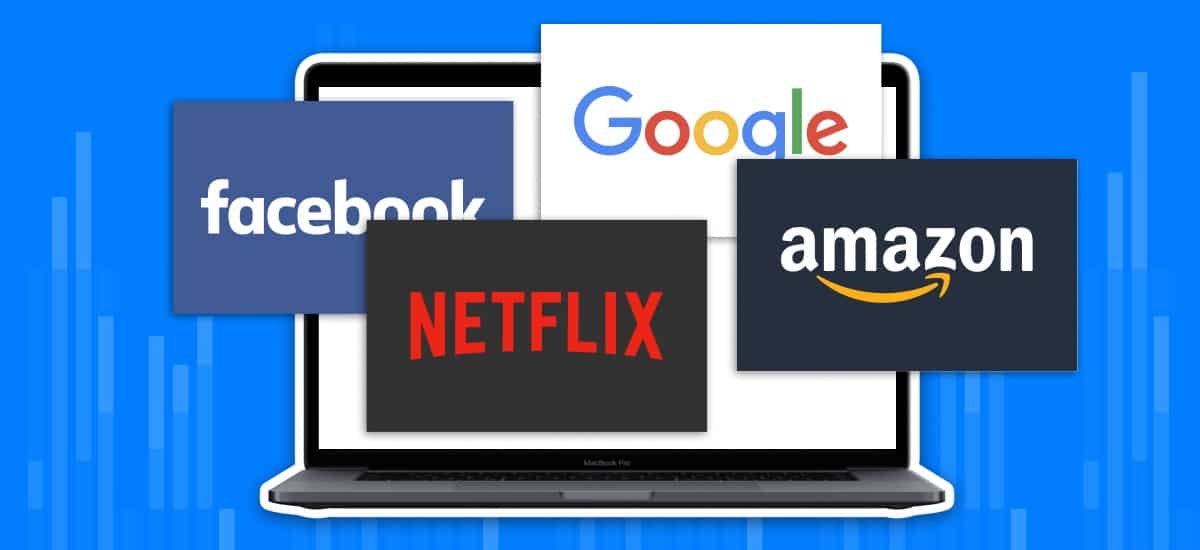This week, FANG (Facebook, Apple, Netflix, Google) stocks reported earnings. Despite an unprecedented quarter fueled by COVID-19, FANG stocks walked away relative winners: AMZN is stepping on the gas while physical retail stores close; NFLX subscribers are surging while cord cutting accelerates; and FB & GOOG both benefit from the strength in DR while Brand pulls back (both were able to capitalize on a falling stock price by repurchasing stock.)
Here are the highlights:
- Netflix (NFLX) came away with blowout net adds, while also demonstrating the scalability of their model–with margins rising above 600bps in Q1 and guiding to nearly 400bps expansion in Q2.
- Amazon (AMZN) results were more mixed. Paid units, revenue, and AWS backlog all accelerated, but operating margins took a step back (even with a boost from changing their depreciable life and higher capacity utilization on the AWS side), leaving at least some question around the structural cost of scaling ecommerce logistics.
- Facebook (FB) took hits on the brand side, but even with that, held revenues flat in April while engagement ripped higher and Zuck signaled a new appreciation for Margins.
- Google (GOOG) saw stabilization and (heavily caveated) green shoots in April while roughly doubling the number of shares bought back in March vs. Jan/Feb, but continues to sit on >$100bn of cash and provided little comfort in the LT margin trajectory.
- Unlike the rest of the world, FANG continues to hire and invest, notably AMZN reinvesting $4bn in Q2 alone and FB hiring over 10,000 workers in product and engineering this year.
Below, you’ll find analyst commentary paired with quotes pulled directly from FANG earnings call transcripts. Interested in keeping track of FANG stocks? Start your free trial of AlphaSense now or login to your account.
Please note highlighting:
Green highlights: positive sentiment
Red highlights: negative sentiment
Yellow highlights: noted by analyst
Amazon Earnings: Q1 2020
Amazon meaningfully accelerated both Paid Units and Revenue growth. Paid Units went from 22% to 32% and Revenue moved from 21% to 27% ex FX. Operating Income came in line with consensus at $4.0bn, slightly down from $4.4bn in Q1’19. AWS grew 33%, nearly flat with the 34% last quarter, but importantly the backlog grew 58% which is a 500bps acceleration from last quarter.
AMZN likely maintains their high-20s revenue growth in Q2 given their track record of coming in towards the high end of Revenue guidance, which for Q2 was set at 18-28%. Bezos surprised investors by commenting that while they would have >$4bn of operating profit in Q2, they plan to reinvest all $4bn into the business and are guiding to breakeven.
“If you’re a shareowner in Amazon, you may want to take a seat, because we’re not thinking small. Under normal circumstances, in this coming Q2, we’d expect to make some $4 billion or more in operating profit. But these aren’t normal circumstances. Instead, we expect to spend the entirety of that $4 billion, and perhaps a bit more, on COVID-related expenses getting products to customers and keeping employees safe.” (AMZN Q1 2020 Earnings Call Transcript)
Investors are trying to determine how much of the $4bn cost is one-time vs. structural in nature. Interestingly, management suggested supply and logistics were the constraints to Q2 revenue–they essentially have demand for whatever they can ship. The question is simply what is the structural cost to fulfill that demand. Undoubtedly, Amazon’s investments will raise the bar for the rest of Retail – at the same time they’re struggling mightily with store closures and networks not built around e-commerce.
“Well, we are heavily constrained — again, it’s an odd quarter because generally, the biggest uncertainty we have is customer demand and what they’ll order and how much of it they’ll order. Demand has been strong. And the biggest questions we have in Q2 are more about ability to service that demand and that — the products that people are ordering in a full way, not blocking or making it hard to find nonessential items, increasing marketing and everything else. So I think the challenge is really on everything besides the top line. Top line is certainly not to be taken for granted. There’s always the importance of having attractive offerings in stock for customers. But usually, things that you can count on, the cost structure, the ability to get products, your capacity for shipping and delivering, those are usually things that you can take for granted and in this quarter, you can’t. And that’s really where the uncertainty is driven.” (AMZN Q1 2020 Earnings Call Transcript)
Subscription Services growth moderated a bit from 32% to 29%, but dollars added sequentially accelerated. Plus, advertising revenue growth remained consistent with Q4, showing the resilience of Promoted Listings, despite the broader pullback in marketing spend.
Management called out strength in household staples, health & personal care, and grocery, which, combined with the mix shift towards 1P, likely drove weaker margins.
“While customer demand remains high, the incremental revenue we are seeing on many of the lower ASP essential products is basically coming at cost. We’ve invested more than $600 million in COVID-related costs in Q1 and expect these costs could grow to $4 billion or more in Q2. These include productivity headwinds in our facilities as we provide for social distancing and allow for the ramp-up of new employees; investments in personal protective equipment for employees; enhanced cleaning of our facilities; higher wages for our hourly teams and hundreds of millions of dollars to develop COVID-19 testing capabilities.
In Q1, we also had another $400 million of costs related to increased reserves for doubtful accounts. On the flip side, we did see a drop in travel, entertainment and meeting costs as well as lower market has weighted and dampen our demand for nonessential items.” (AMZN Q1 2020 Earnings Call Transcript)
Google Earnings: Q1 2020
GOOG missed on EPS ($9.87 vs. $10.73 Street) driven by weaker Core operating margins and higher than expected losses in Other Bets. Higher Other Cost of Revenue (ex-TAC) continues to pressure margins. That said, Sites Revenue growth ex-FX came in at 13%, which, although down from ~20% in Q4, was better than feared. Further, management uncharacteristically gave commentary on the exit rate out of March and early April trends. March Search revenue declined at a mid-teens rate (vs. +9% in Q1 overall) but the (heavily caveated) early signs of recovery in April alleviated fears and drove the stock higher.
And then for the second quarter, so far, I think it’s premature to gauge given uncertainty in the environment. And a few weeks, obviously, is not a quarter. So in such an unprecedented crisis, I would not want you to extrapolate from just a couple of weeks. That being said, the decline in our search and other ads revenue was abrupt in March. And although we’re seeing some early signs at this point that users are returning to more commercial behavior, it’s not clear how durable or monetizable that will be. So based on our estimates from the end of March through last week, for Search, we haven’t seen further deterioration in the percentage of year-on-year revenue declines. For YouTube, direct response has remained strong. However, we’ve seen a continued decline in brand advertising, and it’s really too early to add more. I think the main point, though, is a few weeks, obviously, is not a quarter. And given it is such an unprecedented environment, I would not extrapolate from these comments for the full quarter. (GOOG Q1 2020 Earnings Call Transcript)
Youtube decelerated to high-single digits (vs. +33% for Q1 overall) but remained positive. Management called out continued weakness in Brand spend but relative strength in DR. Investors were also encouraged by Ruth’s commentary that opex and capex would moderate from prior guidance, providing support to margins, as they slow headcount and reduce marketing spend.
More specifically, with respect to the pace of hiring, last quarter, I indicated that the rate of head count growth in 2020 would be slightly higher than the 20% growth in 2019. We now anticipate a deceleration in head count growth that should start to be visible in the third quarter and continue into the fourth quarter. Although we are focused on these and other steps to moderate the overall pace of investment, we remain committed to the long-term opportunities for which we are well positioned. So we will continue to invest in these areas, including Search, machine learning and Google Cloud. (GOOG Q1 2020 Earnings Call Transcript)
Google actually stepped up their buyback rate to $3.8bn in the month of March, roughly doubling the number of shares purchased in Jan/Feb. This is a welcome signal to investors, but Google continues to sit on >$100bn of cash.
And then on your second question on capital returns, we believe a share repurchase program for us, appropriately sized, is responsible in the current environment based on our capital allocation framework and our cash balance. So at the beginning of the year, I indicated that we expected to repurchase shares at a pace at least consistent with the fourth quarter on the remaining authorization, and that remains our view for the second quarter. (GOOG Q1 2020 Earnings Call Transcript)
Google is benefiting from the strength in gaming and e-commerce which have seen lockdown driven surges. Now that the advertising trough seems to be in, investors will shift to looking for the shape of the recovery.
Facebook Earnings: Q1 2020
Facebook reported EPS of $1.71, essentially in-line with Street at $1.75. Ad Revenue ex-FX grew 19% in Q1’20, decelerating from 26% in Q4’19. Importantly, FB commented that they’ve seen stability in April with the first three weeks actually flat year-over-year. Far better than feared April trends, along with strong engagement and shareholder-friendly commentary on margins, drove the stock higher.
Given the increasing uncertainty in our business outlook, we are not providing specific revenue guidance for the second quarter or full year 2020. Rather, I would like to provide a snapshot of revenue performance in the second quarter thus far. There is a tremendous amount of macro uncertainty. So it’s difficult to extrapolate performance based on a small sample of data. After an initial steep decrease in ad revenue in March, we have seen signs of stability reflected in the first 3 weeks of April. Ad revenue has been approximately flat compared to the same period a year ago, down from the 17% year-over-year growth in the first quarter of 2020. The April trends reflect weakness across all of our user geographies as most of our major countries have had some sort of shelter-in-place guidelines in effect. We are understandably cautious given that most economists are forecasting a global GDP contraction in Q2, which, if history were a guide, would suggest the potential for an even more severe advertising industry contraction.
Engagement was strong across the board with Family Daily Active People rising 12% year-over-year to 2.36bn people. Italy, one of the hardest hit countries, saw time spent on FB properties rise 70%. Overall ad impressions rose 39%. Similar to Netflix, FB cautioned that engagement strength would ease as shelter-in-place restrictions are relaxed.
Management reduced guidance for operating expenses to $52-56bn from $54-59bn. Despite the reduction, Mark made a point to highlight FB will be hiring >10k people in product and engineering this year to both press on their competitive advantage as well as aid the economic recovery. He also said that the economic pullback has reinforced to him the importance of maintaining high margins – which will surely be music to investor’s ears. Capex will be in the range of $14-16bn vs. $17-19bn prior, but management caveated that this should be viewed as a deferral into 2021 given the demands on infrastructure from increased engagement.
We accepted that our profit margins will decrease this year as we continue investing, and Dave will share more on our financial outlook in a few minutes. But this economic pullback has certainly reinforced for me the importance of maintaining high margins. Our financial position has allowed us to continue investing in building products and making investments like our partnership with Jio even when the underlying economic conditions are challenging.
Similar to GOOG, FB benefited from the surge in gaming and ecommerce driving DR spend as brand advertising has fallen off.
So Brian, yes, the trends that we saw in the end of Q1, we saw a pullback — pretty broad-based pullback, especially concentrated in some of the areas that we talked about, things like travel and auto, but really kind of broad-based, large and small advertisers. We saw relative strength even then in a few categories like gaming, where you have always-on campaigns that we’re able to pick up some supply because the lower pricing kind of cleared at the levels that those advertisers were trying to acquire users at. So that is one of the benefits of the auction. And then e-commerce, we’ve seen was not as strong as gaming, but we’ve seen that show signs of stability as well and all of those trends sort of continued into Q2. So I don’t think there’s a lot of vertical shifts, but I think we’ve seen e-commerce sort of do reasonably well. What we’re seeing is really, I think, pretty straightforward. We’re seeing people who are driving towards online conversion events do well because they’re able to — they’re able to kind of bid in the auction and get those users and get those results that they’re looking for. And people who are like looking for off-line or more top-of-funnel brand, there, we’ve seen more pullback in spend.
Netflix Earnings: Q1 2020
Netflix reported a blowout subscriber number, adding 15.8m net adds vs. guidance of 7.0m and 9.6m in Q1’19. While Q2 guidance was characterized as a “complete guess,” net add guidance of 7.5m was also meaningfully ahead of consensus and nearly 3x the 2.7m added in Q2’19. Management did temper expectations by suggesting strong net adds in 1H at least in part reflected a pull-forward of demand. The conservative messaging on 2H, combined with the runup into the print, led to a muted stock price reaction to earnings.
The things we are certain of is the Internet is growing. It’s a bigger part of people’s lives, thankfully. And the people want entertainment. They want to be able to escape and connect, whether times are difficult or joyous. That’s pulling up. We’ve had an increase in subscriber growth in March. It’s essentially a pull forward of the rest of the year. So our guess is that subs will be light in Q3 and Q4 relative to prior years because of that. But we don’t use the words guess and guesswork lightly. We use them because it’s a bunch of us feeling the wind, and it’s hard to say. But again, will Internet entertainment be more and more important over the next 5 years? Nothing has changed in that
Originals continue to drive the business with Tiger King: Murder (64m viewers), Love is Blind (30m), Spenser Confidential (85m), and Money Heist (a projected 65m). Netflix will be without 2 of their biggest series in Q3 this year (Stranger Things and Money Heist) which leads to tougher comps compared to Q3’19. This, along with the pull-forward from coronavirus, explains management’s “current guess” that 2H net adds will be lower YoY.
“Hopefully, progress against the virus will allow governments to lift the home confinement soon. As that happens, we expect viewing and growth to decline. Our internal forecast and guidance is for 7.5 million global paid net additions in Q2. Given the uncertainty on home confinement timing, this is mostly guesswork. The actual Q2 numbers could end up well below or well above that, depending on many factors including when people can go back to their social lives in various countries and how much people take a break from television after the lockdown. Some of the lockdown growth will turn out to be pull-forward from the multi-year organic growth trend, resulting in slower growth after the lockdown is lifted country-by-country. Intuitively, the person who didn’t join Netflix during the entire confinement is not likely to join soon after the confinement. Plus, last year we had new seasons of Money Heist and Stranger Things in Q3, which were not planned for this year’s Q3. Therefore, we currently guess that Q3’20 and Q4’20 will have lower net additions than last year due to these effects.” Netflix (4/21 – 8K)
ARPU was a bit light of expectations as coronavirus led to a strengthening of the USD, especially relative to Latam currencies. Despite the ARPU pressure, NFLX reiterated its 16% GAAP Operating Margin guidance for 2020.
Management also relieved at least some concern over production pauses leading to a gap in content by explaining a less well-understood aspect of their business — they shoot far out relative to the industry — which means their 2020 slate is essentially set.
Yes. Well, the one thing that’s maybe not widely understood is we work really far out relative to the industry because we launch our shows all episodes at once. And we’re working far out all over the world. So our 2020 slate of series and films are largely shot and are in post-production remotely in locations all over the world. So — and we’re actually pretty deep into our 2021 slate. So we’re not — we aren’t anticipating any moving — moving things around. And to give you some examples, The Crown, in its fourth season; our big fourth quarter animated release, Over the Moon. These are shot productions in our — in the finishing stages right now to release later this year as planned. So we don’t anticipate moving the schedule around much and certainly not in 2020.
As a result of pausing production (as well as scaling the business), Free Cash Flow burn will meaningfully improve to under $1bn from prior guidance of $2.5m and 2019 levels. FCF materially improving with an unchanged 2020 slate gives investors a directional proof point in the Company closing the gap between FCF and EPS in the long run. That said, they did allude to 2021 potentially being a step back in the path to cash breakeven as they re-ramp production.
With our productions currently paused, this will shift out some cash spending on content to future years. As a result, we’re now expecting 2020 FCF of -$1 billion or better (compared with our prior 2020 expectation of -$2.5 billion and -$3.3 billion actual in 2019). This dynamic may result in more lumpiness in our path to sustained FCF profitability (as, prior to the pandemic, we had been planning for annual improvement in FCF). However, there has been no material change to our overall time table to reach consistent annual positive FCF and we believe that 2019 will still represent the peak in our annual FCF deficit. (Netflix 4/21 – 8K)
NFLX cemented themselves as one of the biggest beneficiaries of Coronavirus – but as Reed said, it’s really just accelerating the multi-year secular shift towards streaming.
Interested in keeping track of FANG stocks? Start your free trial of AlphaSense now or login to your account.



